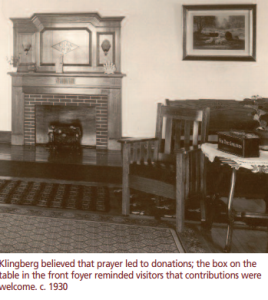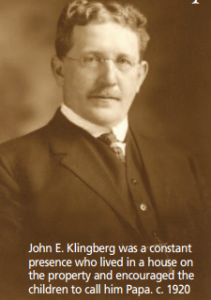by Briann Greenfield with McKinley Frey, David Kluczwski, Cheryl LeBeau, William McGannon, Keith Miller, Alan Patterson, Stefanie Ryan, Valerie Werse, and Aileen Zylman.
All images courtesy of the Klingberg Family Centers.
(c) Connecticut Explored Inc. WINTER 2008
Subscribe/Buy the Issue!
“Don’t cry wifie, these boys are a new addition to our family,” John E. Klingberg writes of telling his wife Magdalene, herself pregnant with their third child, after taking in three abandoned boys found in a New Britain shack in 1903.
Klingberg, a Swedish immigrant and pastor of New Britain’s Elim Baptist Church, took the boys’ presence as a long-awaited sign from God directing him to create an orphanage. From this small beginning grew a 150-bed facility that has been home to thousands of children. Today, Klingberg Family Centers serves children and families throughout Connecticut with four campuses dedicated to helping children and restoring families.
Born in 1867 in Saxhyttan, Sweden to an alcoholic father who was unable to provide for his family, Klingberg was bonded into years of servitude. At age 24, he relocated to America in 1891, settling in Chicago, a major center of social reform. He entered seminary and in 1900 accepted the pastorate in New Britain, Connecticut, a city populated by many new immigrants and home to an established Swedish community.
“Child saving” was a key concern of late 19th- and early 20thcentury reformers who understood the destabilizing effects of industrial capitalism on working-class families. In an era before government welfare programs (today’s federal programs had their roots in the Social Security Act of 1935, though some states offered “Mothers’ Pensions” earlier), private orphanages functioned as a safety net where families beset by unemployment, illness, or death could place children they could no longer support. Not all children in orphanages were parentless.
Klingberg started the New Britain Children’s Home in a small rented house in the Ozone Heights section of New Britain in 1903, expanding into a second building the following year. The resident children attended public schools, and unmarried “matrons” lived with them full time, providing daily care.
The children attended morning chapel services, Sunday school, and church services at Elim Baptist Church. They were taught about Jesus’ love to compensate for personal losses. Children came from a national network of Baptist churches. New Britain’s Catholic Polish community built its own orphanage, Our Lady of Rose Hill, in 1904. While united in their concern for children, the two institutions represented competing ideologies in a city often divided by ethnicity and religion
In 1920 Klingberg laid the cornerstone for a new building located on 40 acres in Rackliffe Heights, an undeveloped section of New Britain on one of the city’s highest hills. There he established a farm where children could experience rural life and built one large facility, with a wing for girls and one for boys, to house all the children. To today’s eyes, the building’s rows of steel beds, expansive dining hall, and industrial-sized kitchen look cold and severe. Child welfare advocates of the 1920s shared those concerns and often advocated small cottages in which about 20 children would live and function as a large family. Klingberg felt that centralization was a necessary economic solution to the difficult problem of housing so many children.
 Photographs preserved in the Klingberg Family Centers archives show children playing, carrying dolls, dressing up, and swimming in the Home’s in-ground pool. But growing up in the Home could be difficult. Klingberg did not place children for adoption or in foster homes. Because of this policy, children had stability and the possibility of reunion with remaining family members. But it also meant that many would leave the Home with little knowledge of family life.
Photographs preserved in the Klingberg Family Centers archives show children playing, carrying dolls, dressing up, and swimming in the Home’s in-ground pool. But growing up in the Home could be difficult. Klingberg did not place children for adoption or in foster homes. Because of this policy, children had stability and the possibility of reunion with remaining family members. But it also meant that many would leave the Home with little knowledge of family life.
John Klingberg died in 1946 at age 78. His son, the Reverend Haddon Klingberg, assumed the directorship of the Home.
By the 1960s, hundreds of orphanages across the country closed under harsh criticism for their inability to provide a family environment for dependent children. Some institutions, including the Klingberg
Home, adapted. In 1968, The Klingberg Children’s Home began a successful transformation into a residential treatment center for children and families.
Today, the Klingberg Family Centers is dedicated to building healing relationships that empower children and families and help them reach their full potential. It offers programs and services for people whose lives have been seriously disrupted by abuse, divorce, addiction, and mental illness. Klingberg Family Centers also fosters relationships with its alumni and maintains an archive of the institution’s history. Former residents interested in researching their histories should contact Mark H. Johnson, vice president, at (860) 832-5526 or markj@klingberg.org.
For his assistance with this article, special thanks to Mark H. Johnson, whose grandparents worked at the Klingberg orphanage and whose memories of his youth include playing with the children there.
Explore!
Read more stories about the history of CHILDHOOD in Connecticut on our TOPICS page.


